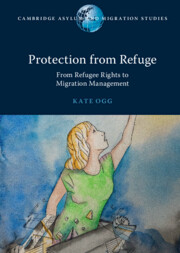Book contents
- Protection from Refuge
- Cambridge Asylum and Migration Studies
- Protection from Refuge
- Copyright page
- Dedication
- Contents
- Preface
- Acknowledgements
- Abbreviations
- 1 Journeys in Search of Refuge
- 2 Refuge as a Concept and a Place
- 3 Using Human and Refugee Rights to Resist Encampment
- 4 Using Human Rights Law to Travel in Search of Refuge in Europe
- 5 Direct Challenges to Regional Containment Instruments
- 6 Seeking Refuge as a Palestinian Refugee
- 7 Resisting the Prospect of Refuge in an IDP Camp
- 8 Elusive Refuge
- Index
5 - Direct Challenges to Regional Containment Instruments
Published online by Cambridge University Press: 17 March 2022
- Protection from Refuge
- Cambridge Asylum and Migration Studies
- Protection from Refuge
- Copyright page
- Dedication
- Contents
- Preface
- Acknowledgements
- Abbreviations
- 1 Journeys in Search of Refuge
- 2 Refuge as a Concept and a Place
- 3 Using Human and Refugee Rights to Resist Encampment
- 4 Using Human Rights Law to Travel in Search of Refuge in Europe
- 5 Direct Challenges to Regional Containment Instruments
- 6 Seeking Refuge as a Palestinian Refugee
- 7 Resisting the Prospect of Refuge in an IDP Camp
- 8 Elusive Refuge
- Index
Summary
In Chapter 5, I examine cases in which refugees directly challenge regional containment instruments. This has occurred in North America (a safe third-country agreement between the US and Canada), Asia-Pacific (offshore processing agreements between Australia and Malaysia, Australia and Papua New Guinea and Australia and Nauru), Europe (the Dublin System and a refugee swap agreement between Europe and Turkey) and Libya (an externalisation agreement between Libya and Italy). I examine the ways decision-makers manoeuvre juridical borders in constructing ideas of refuge and determining the legality of states’ attempts to prevent refugees crossing international borders. I observe that when courts consider the significance of refugeehood and expand their juridical borders, they set high thresholds for refuge and characterise it as a duty owed by states. However, in most cases courts ignore the salience of refugee status and retract their juridical borders. This means that there is no minimum standard of refuge set and refuge morphs from an obligation to a discretion. Refugees become trapped in the resisted place of refuge, unable to continue their journey except in extraordinary circumstances. What is considered exceptional is highly gendered with the narrow frameworks developed sidelining experiences of male and also many female refugees.
Keywords
- Type
- Chapter
- Information
- Protection from RefugeFrom Refugee Rights to Migration Management, pp. 112 - 148Publisher: Cambridge University PressPrint publication year: 2022

